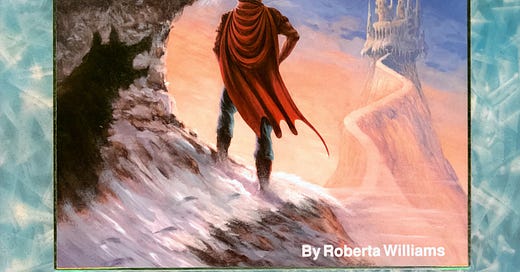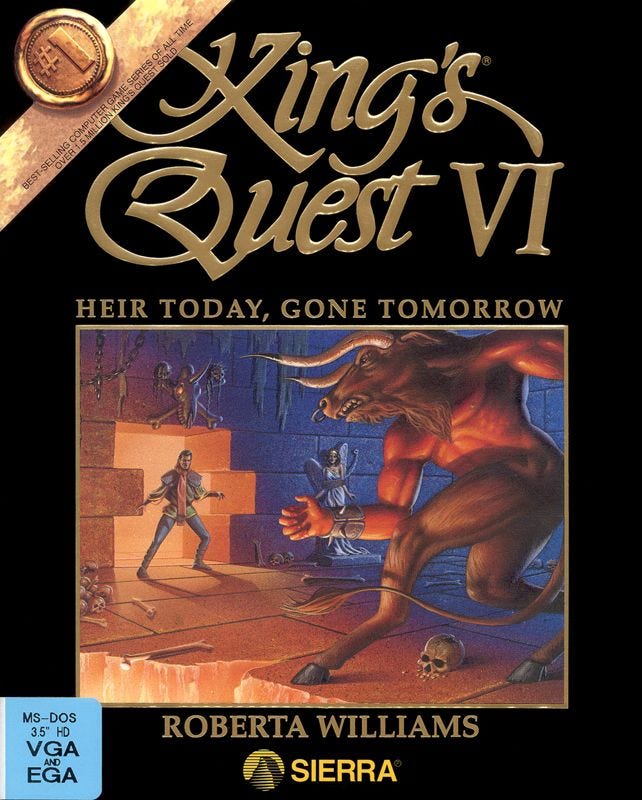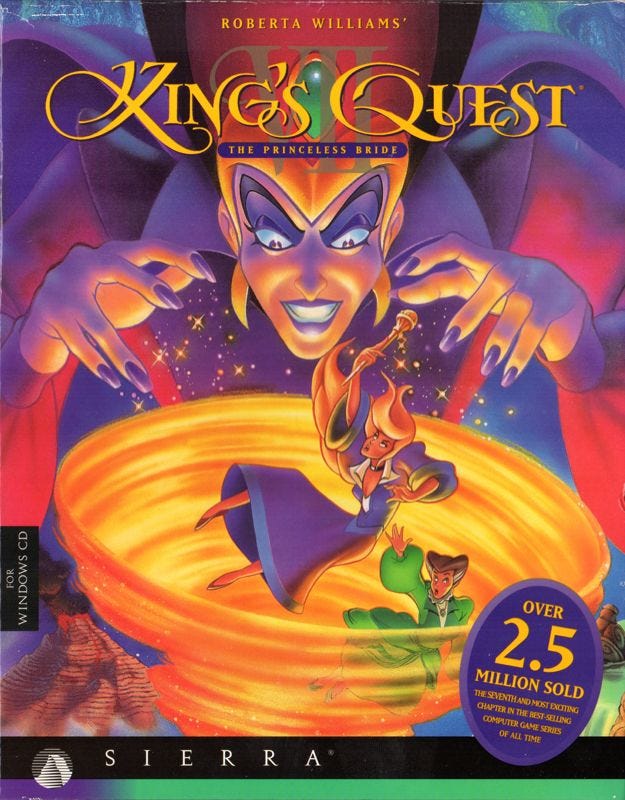Notes, once again:
All images are taken from Wikimedia Commons with the exceptions of the sixth, seventh and eighth games.
The second part covers King’s Quest 5, 6, 7, and 8.
Due to Substack’s limitations on emails, this newsletter will split the game series into two parts.
This series doesn’t cover the 2015/2016 reboot of the game.
Welcome to the second part of the King’s Quest series. The first four did not have any voice acting, and King Graham (originally from the first three games, including the aforementioned fifth game) and his daughter Princess Rosella (originally from the fourth game) made appearances in Hoyle Games, with the exception of the second game, and in the case of the fourth game, only Graham appeared. This part does have voice acting.
King’s Quest V: Absence Makes the Heart Go Yonder!
King's Quest V, originally released in late 1990, featured a significant improvement in graphics (achieved through the introduction of VGA into the series). It was also the first King's Quest installment to replace the typing user interface with a point-and-click user interface. The title is a spoof on the proverb “Absence makes the heart grow fonder”. It was later released as a fully voiced “talkie” CD-ROM, done by members of the Sierra staff, and is the first game in the series to feature voice acting. The game over messages can be found here on YouTube.
The player returns to the role of King Graham (v.b. Josh Mandel), who finds out that the castle has disappeared, and soon meets a talking owl named Cedric (v.b. Richard Aronson). King Graham travels through the land of Serenia, gathering helpful items and information, and eventually makes his way to Mordack’s island and to his castle lair to save his family from their impending doom. The game did have a Japanese release on the PC-98, but unfortunately, it didn’t have any voice acting, and the graphics are somewhat washed out.
King’s Quest VI: Heir Today, Gone Tomorrow
The sixth game, King’s Quest VI, features the song “Girl in the Tower,” which can be listened to on YouTube. First released in 1992 and written by Roberta Williams and Jane Jensen (who later went on to create the Gabriel Knight series), it is widely recognized as the high point in the series for its landmark 3D graphic introduction movie (created by Kronos Digital Entertainment) and professional voice acting. King’s Quest VI was programmed in Sierra’s Creative Interpreter and was the last King’s Quest game to be released on floppy disk.
A CD-ROM version of the game was released in 1993, including more character voices, a slightly different opening movie, and more detailed artwork and animation. The player takes the role of Prince Alexander (voiced by Robby Benson — who is known for… wait for it… wait for it… the Beast in the Disney film Beauty and the Beast!) as the game’s protagonist, who first appeared in the third game as Gwydion. Like the fourth game, it has multiple endings. This game also includes Dave Fennoy (Rodin in the first three Bayonetta games and Lee Everett in The Walking Dead video game) and the late Tony Jay (Don Claude Frollo in the Disney film The Hunchback of Notre Dame). The game over messages can be found here on YouTube.
King’s Quest VII: The Princeless Bride
Released in 1994, King's Quest VII: The Princeless Bride features high-resolution graphics in a style reminiscent of Disney and Don Bluth animated films and is the first King’s Quest game with multiple protagonists: Queen Valanice (v.b. Carol Bach-y-Rita) and Princess Rosella (v.b. Maureen McVerry), who are both spirited away to the realm of Eldritch, and Rosella is transformed into a troll (pun intended). They must find a way to return Rosella to normal and find her true love, defeat a powerful evil force threatening this realm, and return to the kingdom of Daventry.
This is the only game in which Valanice, the wife of the first two and fifth game’s King Graham, is playable, and the player returns to the role of Rosella, who was first playable in the fourth game. Like the fourth and sixth games, there are multiple endings in this game — except that the good ending has Rosella marrying Edgar, the Prince of Etheria, who had previously appeared in the fourth game, where he was kidnapped by the fairy witch Lolotte before he was rescued by Rosella.
The game overs can be found here on YouTube.
King’s Quest: Mask of Eternity
Released in late 1998, King’s Quest: Mask of Eternity is the first (and only) game in the main series where the main character is neither King Graham nor a member of his family, as well as the first in the series to use a full 3D engine as opposed to the 2D cartoon or pixel style of the earlier games and the first to omit the sequel numbering system on box artwork and title screen. The player takes the role of the tanner, painter and knight of Daventry named Connor, who is not of noble birth, as he rises above his lowly status to save his kingdom and the world, becoming a great hero. Roberta Williams left Sierra after the game’s release (though her husband, Ken, left the company in 1996 before her).
This game was one of Mary Kay Bergman’s final roles (as she was the lead female voice actress on the adult animated television series South Park) until she committed suicide in November 1999, one year after the game’s release. Philece Sampler (original Mimi Tachikawa from Digimon Adventure, Taokaka from BlazBlue, and the original Sabine Cheng in Miraculous Ladybug) was involved in the game before a heart attack killed her on July 1, 2021, 23 years after the game’s release.








